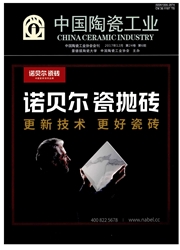

 中文摘要:
中文摘要:
合成了生物活性玻璃(BGC)粉末,采用无压烧结工艺制备了Y—PSZ/BGC陶瓷复合材料,并对其孔径分布、组织成分、血浆浸泡前后表面结构和成分以及粉末材料对血浆蛋白质的吸附进行了分析。结果表明:Y-PSZ/BGC复合陶瓷材料主要含t—ZrO2、m—ZrO2、Na2Ca3Si6O16相;组织结构具有微孔特征,孔的分布比较均匀;BGC的加入使得复合材料具有了生物活性,BGC含量越高,复合材料的生物活性越强。
 英文摘要:
英文摘要:
In this paper, BioacUve Glass Ceramic (BGC) particles were synthesized. Pressureless sintedng was used to prepare yttria-partially-stabilized zirconiaJBGC composites. Fracture photographs of the composite were observed by scanning electron microscope, and the pore diameter distributing of BGC ceramic composites was tested. The composites structure elements were attained by X-ray diffraction. Surface structure and elements of composite were analyzed before and after being dipped in plasma. Plasma absorption of the composite particles was gained by FTIR. The experimental results demonstrated that the composites mainly consist of t-ZrO2, m-ZrO2, Na2Ca3Si6O16 phase. The composites have well-proportioned micropore structure. BGC provides the composites bioactivity. With the increase of BGC, the composites bioactivity improves greatly.
 同期刊论文项目
同期刊论文项目
 同项目期刊论文
同项目期刊论文
 Comparison of tribological behavior of nylon composites filled with zinc oxide particles and whisker
Comparison of tribological behavior of nylon composites filled with zinc oxide particles and whisker Biotribological behavior of ultra high molecular weight polyethylene composites containing bovine bo
Biotribological behavior of ultra high molecular weight polyethylene composites containing bovine bo Research on the structure characterization and the biotribological behaviors of PVA/HA composite hyd
Research on the structure characterization and the biotribological behaviors of PVA/HA composite hyd Research on the Long Time Swelling Properties of Poly (vinyl alcohol)/Hydroxylapatite Composite Hydr
Research on the Long Time Swelling Properties of Poly (vinyl alcohol)/Hydroxylapatite Composite Hydr Research on the friction and wear mechanism of poly(vinyl alcohol)/hydroxylapatite composite hydroge
Research on the friction and wear mechanism of poly(vinyl alcohol)/hydroxylapatite composite hydroge Biotribological behavior of ultra high molecular weight polyethylene composites filled with nano-ZrO
Biotribological behavior of ultra high molecular weight polyethylene composites filled with nano-ZrO Load Dependence of Nanohardness in Nitrogen Ion Implanted Ti6Al4V Alloy and Fractal Characterization
Load Dependence of Nanohardness in Nitrogen Ion Implanted Ti6Al4V Alloy and Fractal Characterization 期刊信息
期刊信息
